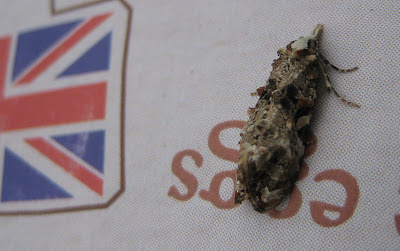Here's a beautiful moth which you can meet without spending money on a light trap: the White Plume, which may flutter from banks of nettles, docks and willowherb on a warm summer's day as you brush past.
It is hearteningly easy to identify and different from the baffling army of other micros, and its wings are quite something. Are there two? Six? or eight? When all four pairs of plumes are unfolded, the last answer is correct.
 |
| Or is it only six wings? |
Mine was extremely skittish, dodging from place to place as I tried to photograph its upper wing and it kept hiding underneath leaves. It never flew far, luckily, but seemed to go for nettles in particular in order to annoy me. Hah! By good chance, my able lieutenant Penny was to hand and nobly held a nettle leaf to persuade the creature to sit for me, while aptly comparing its plumes to Edwardian ladies' ostrich feathers. Is this, I wonder, a birthday hint for 16 July? In a minute, I will be taking her a well-deserved cup of morning tea.
 |
| The bejewelled hand of Pen, plus Plume pretending to have only four wings |
One last thing about this engaging moth. Do you think the designer of the Liberal Democrats' bird logo is a secret plume enthusiast?
Meanwhile in the trap...evidence of how the moth enthusiast can grow blase. Only a couple of weeks ago, I was exulting about the presence of no fewer than seven Elephant Hawks among the eggboxes. This morning, there were seven again, and I was having to stifle a yawn. But then I turned one of the last boxes over - and what was this, on the right in the picture above?
Yes, a Small Elephant Hawk, immediate relative of the standard EH but smaller, subtly different in wing-patterning and found less frequently. I didn't dally and took its pic straight away which was just as well, because the daylight got it worried and in no time it was whirring its wings for take-off and then zooming away. Can you see a third standard Elephant Hawk watching admiringly in the background?




















































